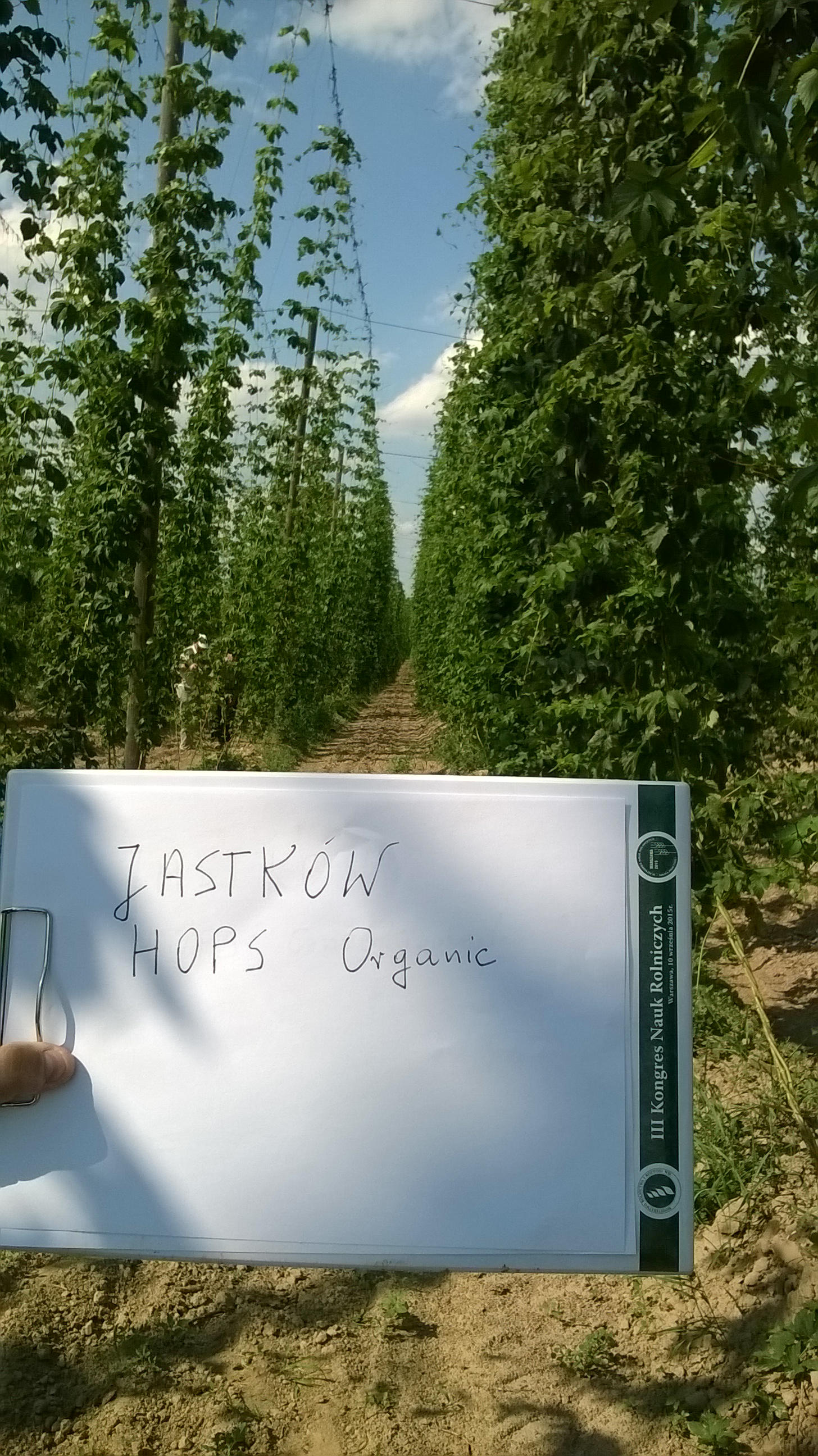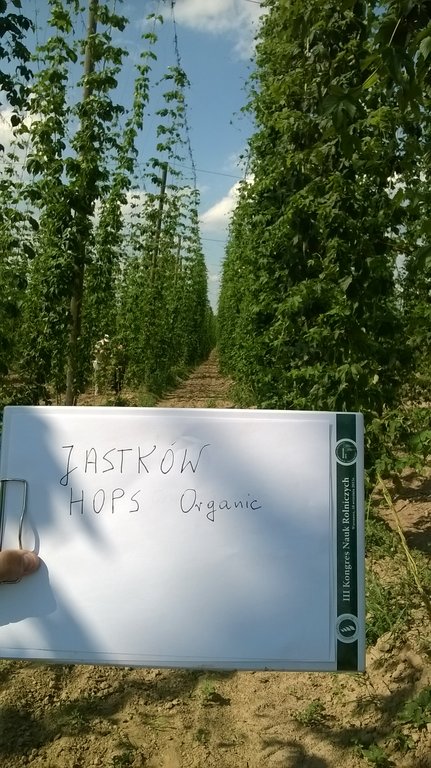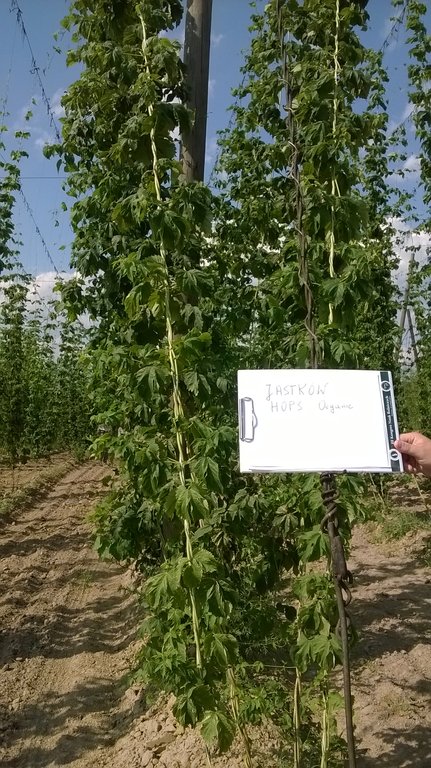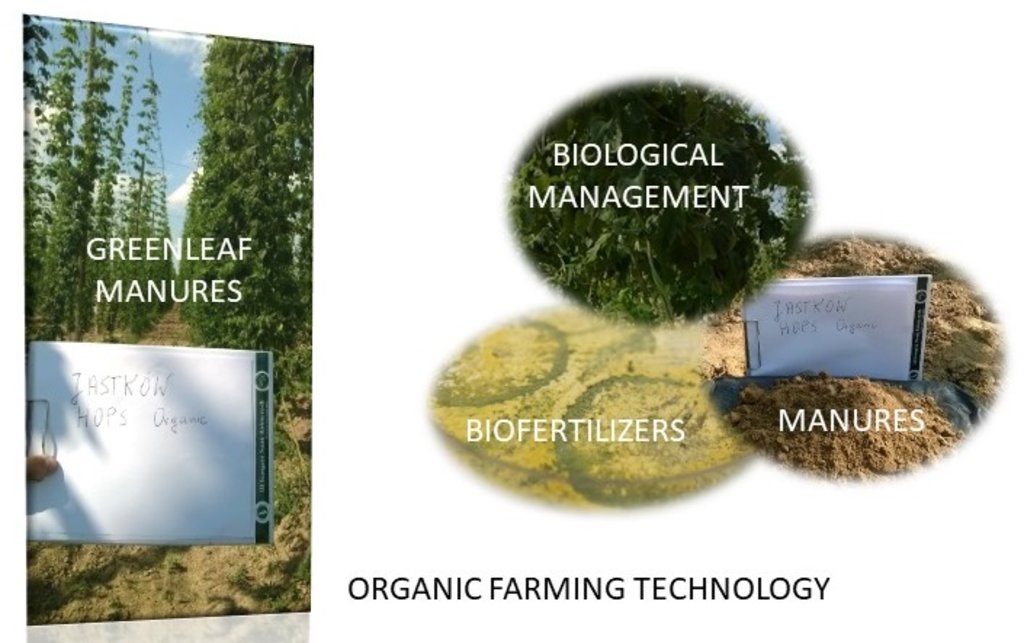Organic agriculture in hop cultivation [Poland]
- Creation:
- Update:
- Compiler: Magdalena Frac
- Editor: –
- Reviewers: Ursula Gaemperli, Gudrun Schwilch
Organic agriculture in hop cultivation
technologies_2852 - Poland
View sections
Expand all Collapse all1. General information
1.2 Contact details of resource persons and institutions involved in the assessment and documentation of the Technology
Lipiec Jerzy
j.lipiec@ipan.lublin.pl
Institute of Agrophysics, Polish Academy of Sciences
Doswiadczalna 4, 20-290 Lublin
Poland
Usowicz Bogusław
b.usowicz@ipan.lublin.pl
Institute of Agrophysics, Polish Academy of Sciences
Doswiadczalna 4, 20-290 Lublin
Poland
Name of project which facilitated the documentation/ evaluation of the Technology (if relevant)
Interactive Soil Quality assessment in Europe and China for Agricultural productivity and Environmental Resilience (EU-iSQAPER)Name of the institution(s) which facilitated the documentation/ evaluation of the Technology (if relevant)
Institute of Agrophysics, Polish Academy of Sciences (IA PAS) - Poland1.3 Conditions regarding the use of data documented through WOCAT
When were the data compiled (in the field)?
30/06/2016
The compiler and key resource person(s) accept the conditions regarding the use of data documented through WOCAT:
Ja
1.4 Declaration on sustainability of the described Technology
Is the Technology described here problematic with regard to land degradation, so that it cannot be declared a sustainable land management technology?
Nee
2. Description of the SLM Technology
2.1 Short description of the Technology
Definition of the Technology:
Integrated pest and disease management including organic agriculture.
2.2 Detailed description of the Technology
Description:
The technology is used in Jastków (N 51.302029 E 22.42336), in Lubelskie Region in Poland under hops. The size of farm with organic hops production is about 6 ha. The case study is embedded in typical agricultural region on rather fertile soils formed from loess. The altitude in the study site is 209 m.a.s.l., average annual temperature 8°C and precipitation 540 mm.
The main characteristics of the technology are the following:
- very strict limits on chemical synthetic pesticide and synthetic fertiliser use,
- absolute prohibition of the use of genetically modified organisms,
- taking advantage of on-site resources, such as composts produced on the farm,
- application of beneficial microorganisms and plants extracts for pest and diseases control. Appropriate measures that discourage the development of pest populations and keep pesticides and other interventions to reduce or minimize risks to human health and the environment.
Organic farming promotes the use of cover crops and crop rotations. Organic residues and nutrients produced on the farm are recycled back to the soil. Cover crops and composted manure are used to maintain soil organic matter and fertility. Preventative disease control methods are practiced, including crop rotation. Integrated pest and weed management, and soil conservation systems are valuable tools on an organic farm. The organic farming technology increases the quality of plants, decreases fertilizers and pesticides use, builds healthy soil, supports water conservation, encourages biodiversity. The major activities needed to establish and maintain the Technology are the following: poles for hops growth, natural fertilizers and bioproducts used in organic farming.
Important principles for the processing of organic products include the keeping agriculture in touch with nature.
The benefits of the Technology are the following:
- responsible use of energy and natural resources,
- maintenance of biodiversity,
- enhancement of soil fertility,
- maintenance of water quality.
The farmers can have a problem with pest and diseases, hovewer they like the yield quality of plants cultivated in organic farming system.
2.3 Photos of the Technology
2.5 Country/ region/ locations where the Technology has been applied and which are covered by this assessment
Country:
Poland
Further specification of location:
Jastków
Comments:
Jastków, Poland, Organic plantation of hops, Coordinates: N 51.30203 E 22.42336
Map
×2.6 Date of implementation
If precise year is not known, indicate approximate date:
- less than 10 years ago (recently)
2.7 Introduction of the Technology
Specify how the Technology was introduced:
- through projects/ external interventions
Comments (type of project, etc.):
The Farmer collaborated with Life Sciences University in Lublin to evaluate the influence of different bioproducts in organic farming system.
3. Classification of the SLM Technology
3.1 Main purpose(s) of the Technology
- improve production
- reduce, prevent, restore land degradation
- preserve/ improve biodiversity
- create beneficial economic impact
- create beneficial social impact
3.2 Current land use type(s) where the Technology is applied

Cropland
- Perennial (non-woody) cropping
Main crops (cash and food crops):
hop
If land use has changed due to the implementation of the Technology, indicate land use before implementation of the Technology:
Conventional agriculture.
3.3 Further information about land use
Water supply for the land on which the Technology is applied:
- rainfed
Number of growing seasons per year:
- 1
3.4 SLM group to which the Technology belongs
- integrated pest and disease management (incl. organic agriculture)
3.5 Spread of the Technology
Specify the spread of the Technology:
- evenly spread over an area
If the Technology is evenly spread over an area, indicate approximate area covered:
- < 0.1 km2 (10 ha)
3.6 SLM measures comprising the Technology

agronomic measures
- A2: Organic matter/ soil fertility

management measures
- M2: Change of management/ intensity level
Comments:
Organic hops plantation.
3.7 Main types of land degradation addressed by the Technology

chemical soil deterioration
- Cn: fertility decline and reduced organic matter content (not caused by erosion)
- Cp: soil pollution

biological degradation
- Bq: quantity/ biomass decline
- Bl: loss of soil life

water degradation
- Hq: decline of groundwater quality
3.8 Prevention, reduction, or restoration of land degradation
Specify the goal of the Technology with regard to land degradation:
- prevent land degradation
4. Technical specifications, implementation activities, inputs, and costs
4.1 Technical drawing of the Technology
4.2 Technical specifications/ explanations of technical drawing
Infografics presents the organic farming technology: high plant and soil quality and beneficial microorganisms application.
The main characteristics of the technology are the following:
- very strict limits on chemical synthetic pesticide and synthetic fertiliser use (BIOLOGICAL MANAGAMENT),
- taking advantage of on-site resources, such as composts produced on the farm (MANURES),
- application of beneficial microorganisms and plants extracts for pest and diseases control (BIOFERTILIZERS).
4.3 General information regarding the calculation of inputs and costs
Specify how costs and inputs were calculated:
- per Technology area
Indicate size and area unit:
1 ha
other/ national currency (specify):
PLN
Indicate exchange rate from USD to local currency (if relevant): 1 USD =:
0.28
Indicate average wage cost of hired labour per day:
50-100 PLN
4.4 Establishment activities
| Activity | Type of measure | Timing | |
|---|---|---|---|
| 1. | Building of terraces | Management | Spring, Summer or Autumn |
| 2. | Manure storage | Management | Spring, Summer or Autumn |
4.5 Costs and inputs needed for establishment
If possible, break down the costs of establishment according to the following table, specifying inputs and costs per input. If you are unable to break down the costs, give an estimation of the total costs of establishing the Technology:
5000.0
Comments:
The costs include building of terraces for hop production and costs of plants.
4.6 Maintenance/ recurrent activities
| Activity | Type of measure | Timing/ frequency | |
|---|---|---|---|
| 1. | Biofertilizers application | Agronomic | Spring, Summer or Autumn |
| 2. | Pests and diseases control (plants extracts application) | Management | Spring, Summer or Autumn |
4.7 Costs and inputs needed for maintenance/ recurrent activities (per year)
If possible, break down the costs of maintenance according to the following table, specifying inputs and costs per input. If you are unable to break down the costs, give an estimation of the total costs of maintaining the Technology:
500.0
4.8 Most important factors affecting the costs
Describe the most determinate factors affecting the costs:
Energy, equipment and labour.
5. Natural and human environment
5.1 Climate
Annual rainfall
- < 250 mm
- 251-500 mm
- 501-750 mm
- 751-1,000 mm
- 1,001-1,500 mm
- 1,501-2,000 mm
- 2,001-3,000 mm
- 3,001-4,000 mm
- > 4,000 mm
Agro-climatic zone
- sub-humid
5.2 Topography
Slopes on average:
- flat (0-2%)
- gentle (3-5%)
- moderate (6-10%)
- rolling (11-15%)
- hilly (16-30%)
- steep (31-60%)
- very steep (>60%)
Landforms:
- plateau/plains
- ridges
- mountain slopes
- hill slopes
- footslopes
- valley floors
Altitudinal zone:
- 0-100 m a.s.l.
- 101-500 m a.s.l.
- 501-1,000 m a.s.l.
- 1,001-1,500 m a.s.l.
- 1,501-2,000 m a.s.l.
- 2,001-2,500 m a.s.l.
- 2,501-3,000 m a.s.l.
- 3,001-4,000 m a.s.l.
- > 4,000 m a.s.l.
Indicate if the Technology is specifically applied in:
- not relevant
5.3 Soils
Soil depth on average:
- very shallow (0-20 cm)
- shallow (21-50 cm)
- moderately deep (51-80 cm)
- deep (81-120 cm)
- very deep (> 120 cm)
Soil texture (topsoil):
- medium (loamy, silty)
Soil texture (> 20 cm below surface):
- medium (loamy, silty)
Topsoil organic matter:
- medium (1-3%)
5.4 Water availability and quality
Ground water table:
5-50 m
Availability of surface water:
good
Water quality (untreated):
good drinking water
Is water salinity a problem?
Nee
Is flooding of the area occurring?
Nee
5.5 Biodiversity
Species diversity:
- high
Habitat diversity:
- medium
5.6 Characteristics of land users applying the Technology
Sedentary or nomadic:
- Sedentary
Market orientation of production system:
- commercial/ market
Off-farm income:
- > 50% of all income
Relative level of wealth:
- average
Individuals or groups:
- individual/ household
Level of mechanization:
- mechanized/ motorized
Gender:
- men
Age of land users:
- youth
5.7 Average area of land owned or leased by land users applying the Technology
- < 0.5 ha
- 0.5-1 ha
- 1-2 ha
- 2-5 ha
- 5-15 ha
- 15-50 ha
- 50-100 ha
- 100-500 ha
- 500-1,000 ha
- 1,000-10,000 ha
- > 10,000 ha
Is this considered small-, medium- or large-scale (referring to local context)?
- medium-scale
5.8 Land ownership, land use rights, and water use rights
- family
Land use rights:
- individual
5.9 Access to services and infrastructure
health:
- poor
- moderate
- good
education:
- poor
- moderate
- good
technical assistance:
- poor
- moderate
- good
employment (e.g. off-farm):
- poor
- moderate
- good
markets:
- poor
- moderate
- good
energy:
- poor
- moderate
- good
roads and transport:
- poor
- moderate
- good
drinking water and sanitation:
- poor
- moderate
- good
financial services:
- poor
- moderate
- good
6. Impacts and concluding statements
6.1 On-site impacts the Technology has shown
Socio-economic impacts
Production
crop production
Comments/ specify:
The farmer observed lower hops yield, however the quality is better.
crop quality
Comments/ specify:
The organic farming technology increases crop quality by reduction of fertilizers and pesticides use.
risk of production failure
Comments/ specify:
The organic farming technology decreases the risk of production failure due to greater yield quality and stability.
land management
Comments/ specify:
The organic farming technology simplifies land management by less intense machinery uses.
Income and costs
expenses on agricultural inputs
Comments/ specify:
The expenses on agricultural inputs in organic farming technology are reduced due to lower fuel costs.
workload
Comments/ specify:
The workload in organic farming technology increases by higher number of agricultural practices.
Socio-cultural impacts
food security/ self-sufficiency
Comments/ specify:
The no-till technology improves the food security by increased yield quality and stability.
SLM/ land degradation knowledge
Comments/ specify:
Land degradation knowledge is improved by the promotion of the organic farming technology.
Ecological impacts
Water cycle/ runoff
water quality
Comments/ specify:
The water quality increases in organic farming technology due to lower uses of fertilizers and pesticides.
Soil
soil organic matter/ below ground C
Comments/ specify:
The organic farming technology increases soil soil organic matter content due to cover crops between rows and less mineralization of organic matter.
Biodiversity: vegetation, animals
beneficial species
Comments/ specify:
We observed greater quantity of earthworms under organic farming technology compared to the
conventional tilled soil.
pest/ disease control
Comments/ specify:
The use of pesticides and herbicides is not allowed, therefore only plant extracts or bioproducts are used.
Climate and disaster risk reduction
emission of carbon and greenhouse gases
Comments/ specify:
The organic farming technology desreases emission of carbon and greenhouse gases
due to reduction of chemicals uses and reduction of CO2 and other greenhouse gases realising by intensive agriculture.
6.4 Cost-benefit analysis
How do the benefits compare with the establishment costs (from land users’ perspective)?
Short-term returns:
neutral/ balanced
Long-term returns:
very positive
How do the benefits compare with the maintenance/ recurrent costs (from land users' perspective)?
Short-term returns:
neutral/ balanced
Long-term returns:
very positive
6.5 Adoption of the Technology
- single cases/ experimental
If available, quantify (no. of households and/ or area covered):
about 6 ha
Of all those who have adopted the Technology, how many have did so spontaneously, i.e. without receiving any material incentives/ payments?
- 0-10%
Comments:
The farmer collaborates with local research units.
6.6 Adaptation
Has the Technology been modified recently to adapt to changing conditions?
Nee
6.7 Strengths/ advantages/ opportunities of the Technology
| Strengths/ advantages/ opportunities in the land user’s view |
|---|
| Emphasizes the growth of a healthy crop with the least possible disruption to agro-ecosystems and encourages natural pest control mechanisms. |
| Strengths/ advantages/ opportunities in the compiler’s or other key resource person’s view |
|---|
| Emphasizes the growth of a healthy crop with the least possible disruption to agro-ecosystems and encourages natural pest control mechanisms. |
6.8 Weaknesses/ disadvantages/ risks of the Technology and ways of overcoming them
| Weaknesses/ disadvantages/ risks in the land user’s view | How can they be overcome? |
|---|---|
| Plant diseases, weeds growth | Biological plant protection |
| Low crop yield, high costs of production | Buying cheaper bio-preparations |
| Weaknesses/ disadvantages/ risks in the compiler’s or other key resource person’s view | How can they be overcome? |
|---|---|
| Plant diseases, weeds growth | Biological plant protection |
7. References and links
7.1 Methods/ sources of information
- field visits, field surveys
2
- interviews with land users
1
- compilation from reports and other existing documentation
3
Links and modules
Expand all Collapse allLinks
No links
Modules
No modules






